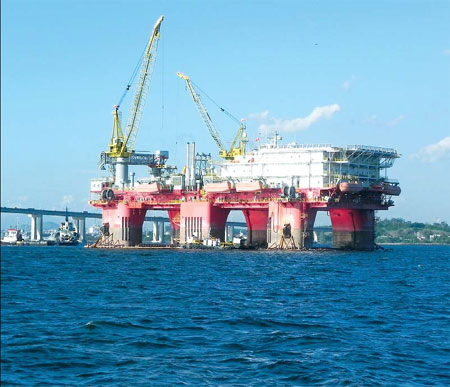Rio de Janeiro state eyes possible oil rush
Updated: 2012-04-30 07:35
(China Daily)
|
|||||||||||
|
A Petrobras platform in the Bay of Guanabara, Rio de Janeiro. |

Vast offshore deposits could fuel further growth of Brazil's petro-zone
The state of Rio de Janeiro is noted for its natural beauty and natural resources, which now include discoveries of so-called pre-salt energy that could be profoundly important to the region's petrochemical industry.
The term pre-salt is associated with fuel resources below a 2,000-meter layer of salt, which is itself below another 2,000 meters of rock in waters 2,000 to 3,000 meters deep in the Atlantic Ocean.
Drilling through the rock and salt to extract underlying oil and gas can be very expensive, though the rewards for both investors and the economy can be very high.
Prior to the recent discoveries of pre-salt oil and gas off the Brazilian coast, Brazil's probable and proven oil reserves were estimated at 20 billion barrels. The number may now well reach 70 billion barrels, but could even surpass 120 billion barrels, according to some industry experts.
It is a bonanza for the already rapidly growing economy.
Based on strong investment and exploration success, Brazil's total production is expected to rise to 5 million barrels per day by 2020, compared with today's figure of 2.7 million bpd.
Brazil's discovery rate is one of the highest on record, with its rate of exploration success currently running at 85 percent. Compare that to the global average of 25 percent and you begin to grasp the strength of this growing sector of the economy and begin to see how Brazil has overtaken economic powers such as the UK, Italy, Russia and India to become the world's sixth-largest economy.
It is easy to understand why there is so much excitement in the country and why all major stakeholders are pushing for more investment and development.
"The pre-salt fields are Brazil's new El Dorado," explained Magda Chambriard, the new president of Brazilian oil regulator ANP and the first woman to hold the position.
"We have the opportunity for Brazil to gain fantastic scale, but we need to be very rigorous with all developments," she said.
If all goes according to plan Brazil could well be on track to export more than 1.5 million bpd in the next few years.
A good start
The country is off to a good start. One of the pre-salt wells has already become a top-producing well yielding 36,000 bpd even though its commercial development only began in 2010.
Yet Chambriard pointed out "further investment in the sector needs to be encouraged to help boost Brazil's industrial development because at the moment only 4 percent of the sedimentary basins thought to hold oil are being researched".
To date investment has already poured in from the Brazilian government through the partly State-owned company Petrobras, the biggest player in Brazil's oil industry and the largest company in Latin America by market capitalization and revenues.
Petrobras now has operations in more than 20 countries and assets worth more than $150 billion. It raised over $70 billion in 2010 in the largest share offering on record to fund development of the offshore basins.
Though its monopoly ended 1997, by 2010 it was still responsible for 91 percent of the crude oil produced in the country and has now become the third largest energy company in the world.
Petrobras plans to invest an additional $225 billion by 2015 as it eyes further development of the pre-salt area and a boost in production.
The share of pre-salt crude in the company's overall production is projected to rise from around the current 2 percent to more than 18 percent by 2015 and as much as 40 percent by 2020.
The company's 2011-2015 business plan includes at least 24 new drilling rigs, seven exploration wells, and new boats and platforms.
Room for others
Petrobras may well be a dominant force in Brazil's oil and gas industry, but that does not mean there is no room for foreign players to invest, operate and grow.
The biggest foreign oil companies include Royal Dutch Shell, Chevron, BG, Statoil and a Japanese consortium known as Frade Japo.
From the government, ANP, and even from Petrobras, the message is clear: foreign investment is welcome and necessary. Foreign companies could also look to expand their interests in Brazil through two anticipated licensing rounds which are expected to take place this year.
Brazil's pre-salt region stretches from Cabo Frio in the state of Rio de Janeiro to Florianpolis in Santa Catarina across an area measuring 160,000 square kilometers.
But it is the state of Rio de Janeiro that has by far the largest oil and gas reserves, so unsurprisingly it is home to the majority of Brazil's energy companies, industry suppliers and oil and gas conferences and events. Due to the pre-salt discoveries the state is now receiving even more attention and investment.
If it is to turn into an old-fashioned oil rush, investment is needed as money further down the supply chain is surprisingly hard to come by.
Petrobras alone has a huge supplier chain of more than 5,000 companies, but 65 percent of them are classed as small with little funding and not always able to offer professional management.
Some private equity fund managers believe that only four percent or 200 of these companies are in a position to interest serious investors. But everyone agrees that one way or another, money will be drawn to Rio de Janeiro and that the state will benefit greatly from the discoveries.
(China Daily 04/30/2012 page14)
